I supporti devono essere aggiunti per trattenere la struttura. Se non fossero presenti supporti, la struttura non sarebbe statica e sarebbe irrisolvibile. It is important to remember that a structure must be restrained in every direction at some point by any of the supports. vale a dire. every degree of freedom must be accounted for by at least one ‘F’ nella struttura.
Similar to the connections between members, the supports are given a 6-digit code to specify which of the node’s degrees of freedom are restrained. Each of the degree of freedom’s must be defined as either Fixed ('F'), Rilasciato ('R') o Primavera('S'). The degrees of freedom are in the following order:
- X Translation
- Y Translation
- Z Translation
- X Rotation
- Y Rotation
- Z Rotation
Ci sono 3 tipi di lettere (o di rilasci) Puoi usare:
- “F” – Fisso – This means the degree of freedom is fully fixed and the member will transfer this force to the node
- “R” – Rilasciato – The force is not being transferred for this degree of freedom
- “S” – Primavera – The force is being transferred with some stiffness factor. This will require additional input.
A pin support (which only allows rotation about the z-axis) would be denoted by the code ‘FFFFFR’ whereas a roller (which allows rotation about the z-axis and movement in the x-direction) would be given the code ‘RFFFFR’.

- Supporto fisso – ‘FFFFFF’ – Fixed in all translations (x,y,z) and rotations (Mx, Mio, Mz).
- Appuntato (Cerniera) Supporto – ‘FFFFFR’ – Fixed in all translations (x,y,z) and but free to rotate about the z-axis (in this 2D case).
- Supporto a Rullo (in x) – ‘RFFFFR’ – Free to ‘roll’ along the x axis and rotate about the z-axis.
- Supporto a Rullo (in y) – ‘FRFFFR’ – Free to ‘roll’ along the y axis and rotate about the z-axis.
- Supporto a molla (in y) – ‘FSFFFR’ – C'è un supporto a molla che consente di trasferire una certa forza nella traslazione y.
Qualsiasi supporto al di fuori di questi preconfigurati può essere digitato manualmente nel file “Codice di restrizione” campo.
Quando vengono applicati i supporti, i codici di fissità si basano sull'asse globale del tuo progetto, non l'asse locale dell'asta ad esso collegata. Per ulteriori informazioni su questi codici fissità, please visit our blog piece on codici di fissità.
I supporti possono limitare il movimento in entrambe le direzioni degli assi o solo in una direzione dell'asse. The 6-character Direction Code in the format XYZxyz specifies the directions that the support restrains (X,E,Z = Translational DOF in GLOBAL X,E,Z axes and x,y,z = Rotational DOF about GLOBAL X,E,Z axes).
For each degree of freedom in translation and rotation, it is possible to define a direction as follows:
- B = Both Axis Directions
- P = Positive Axis
- N = Negative Axis’)
Per esempio: ‘BNBBBB’ = Restrains movement in both axis directions, except the global Y-axis which is only supported in the negative direction.
Insediamenti

Gli assestamenti possono essere utilizzati come un modo per definire un carico di flessione o una flessione fissa in quella posizione. Ad esempio, è possibile applicare uno spostamento di supporto e assestamento in corrispondenza di una campata intermedia di un elemento e l'analisi applicherà tale spostamento in corrispondenza di quella posizione del nodo. Nell'esempio sottostante, una liquidazione positiva di 5 pollici sono stati aggiunti per curvare il raggio verso l'alto:
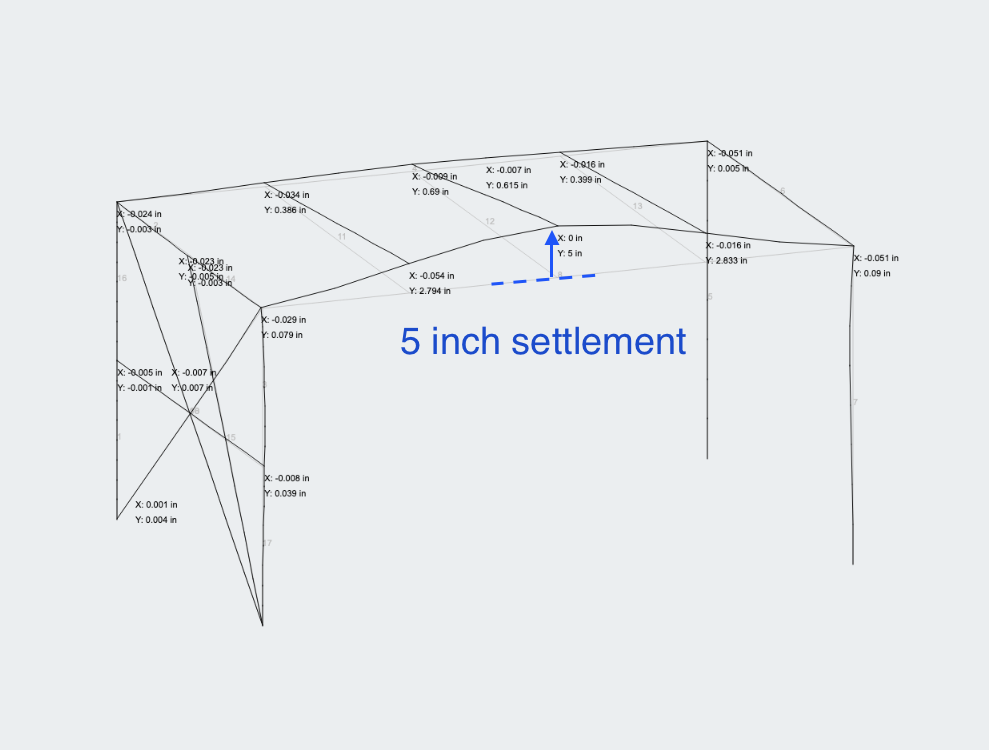
Supporti a molla
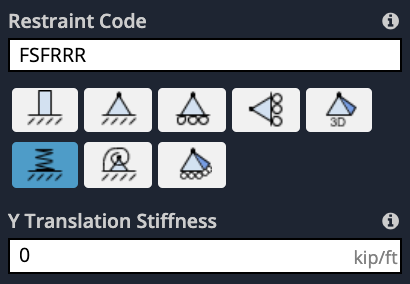
Once the user enters an ‘S” in a particular direction, another input will appear to prompt the user to enter a Stiffness for that particular direction. per esempio. if the user enters a Vertical Spring (like the above example) an input for Y Stiffness Seleziona la casella etichettata. The stiffness input is entered as force/distance (kip/ft, kN / m, eccetera..) which essentially represents how much force is required to compress the spring by a given distance (piede, metro).
The spring stiffness (normally denoted as K) can be calculated in a few different ways (based on Hooke’s Law (F/displacement), or based on the material EA/L) or can be supplied by the manufacturer of the spring support.
Surface Spring Supports
SkyCiv has a powerful integration of springs for Mat foundations. This will help you include the soil elastic stiffness in your model as spring supports. This soil property (Modulo di reazione del sottofondo) is obtained from the geotechnical reports of the site.
In order to define surface spring supports in SkyCiv S3D, primo, you have to select all the plates at the level where the supports will be defined.
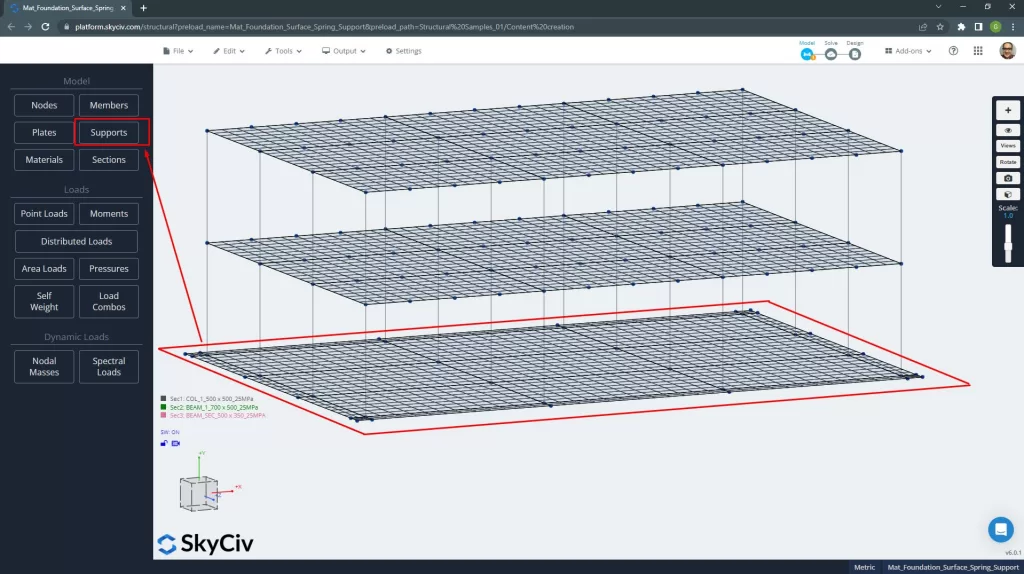
Poi, go to the support button and select the option “Aggiungi un supporto a molla di superficie”.
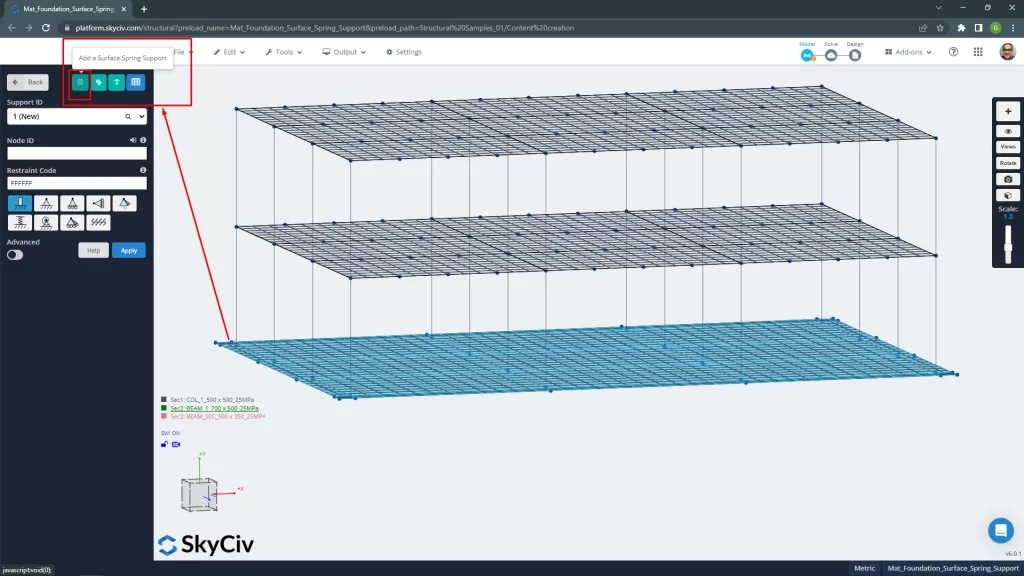
When the prompt window appears, definire il “Modulo di reazione del sottofondo” (units of force over volume), which SkyCiv will convert into node springs.
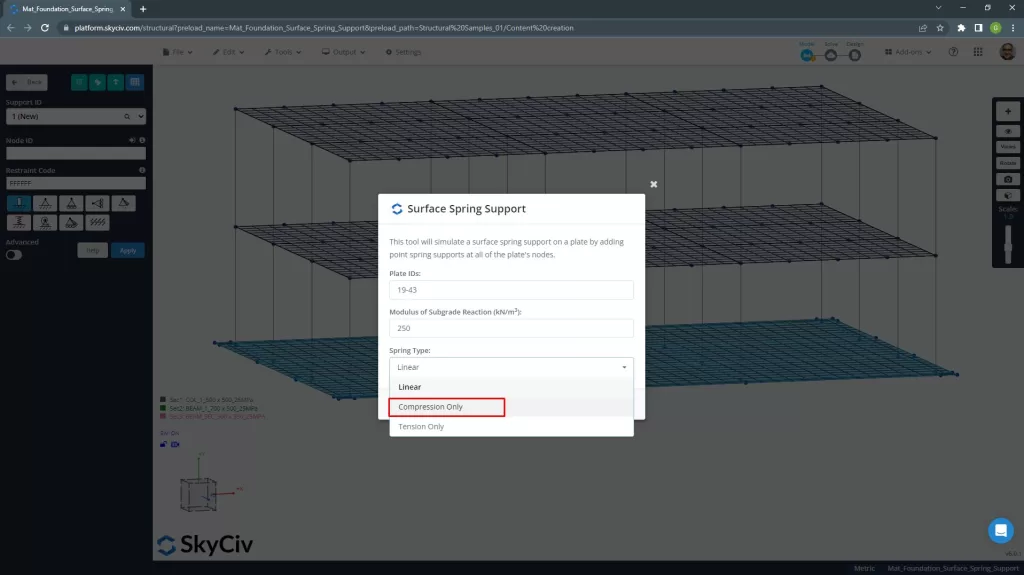
E infine, the software creates a spring support with the equivalent stiffness on each node of the meshed plate.
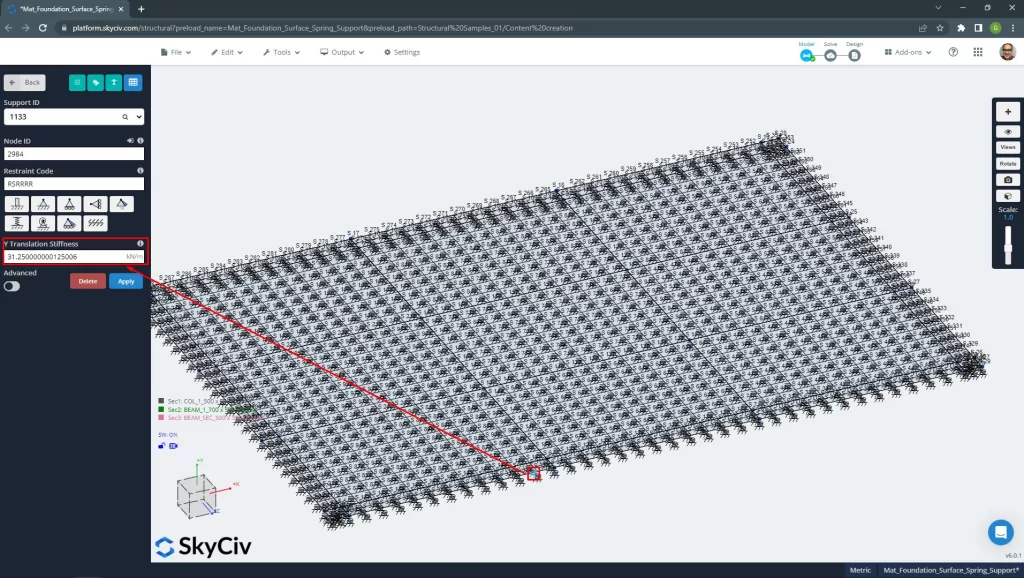
Inclined Supports
If you have a support that is not parallel with the X-Z plane, you can add an inclined support. These supports are not fully fixed or pinned, but are “roller” supports that are free to move in the rotated plane. I risultati della reazione su supporti inclinati saranno ortogonali alla rotazione del supporto. È necessario selezionare un nodo prima di fare clic sul pulsante del supporto inclinato come mostrato.
Per modellare un appoggio inclinato, vai al “supporti” menù, quindi fare clic sul pulsante del supporto inclinato. Apparirà il popup del supporto del rullo inclinato, inserire i dati necessari.

Line Supports
For adding a line support to the edge of a plate, follow the next steps:
- Navigate to the supports view in the left panel
- Selezionare “linea” as the type of support (using the dropdown or the icon)
- Type the IDs of the nodes that define the plate’s edge
- Definire il codice di restrizione di sei caratteri da impostare se ogni grado di libertà è fisso (F), rilasciato (R) o primavera (S)
- Premi Applica


